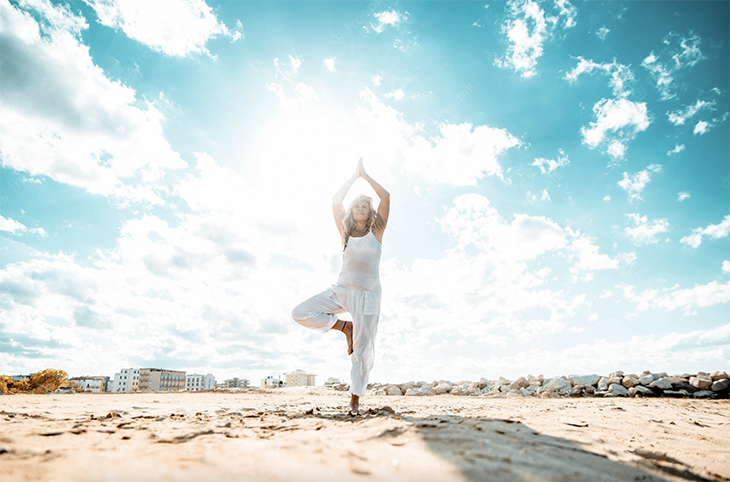Health Risks Go Down For Those Above 50 Years Old If They Are Able To Stand On One Leg For 10 Seconds

They say that health problems come the moment you get older. However, there are also ways to maintain health. If you take care of your mind and body, you’ll age gracefully, and one sign of doing so is being able to stand on one leg by the time you hit 50.
Studies show that middle-aged individuals who are able to stand on one leg for 10 seconds are half as likely to die within the next ten years. This was according to new research conducted. Scientists found that a simple and safe balance test should become part of a routine health checkup for the older members of society.
Aerobic fitness, muscle strength, and flexibility are important factors to consider but there is also something about balance because this ability has the tendency to be well preserved until the 60s and then it starts to wane relatively fast after that.
Unfortunately, balance tests aren’t traditionally come with health checks, especially for the older people. . There may be possible explanations for this, one of which is that there may be no standardized tests. Moreover, the researchers don’t have much data gathered, the ones that connect to injuries or disease that go beyond falling. This was what they have surmised.
A team of scientists hailing from Brazil wanted to know whether a balance test might be considered a reliable indicator of risk of death from any cause. They also wanted to see if this happened within the next ten years. If so, should a test then be included when it comes to routine health checks for older people?
They gathered participants that came from the CLINIMEX Exercise study. This was set up in 1994. In it, the researchers had to assess connections between various measures and degrees of physical fitness versus the risk of poor health (and perhaps even death) that came from cardiovascular issues.
On the other hand, the latest study had more than 1,700 participants that were found in ages 51 to 75 (average age 61) years old during their first check-up. These health checks happened between February 2009 and December 2020. Plus, around two-thirds or 68 percent of the participants were male. They also took into consideration their weight, several measures of skinfold thickness, and waist size were recorded and considered when they looked into the details of their medical history. It also must be noted that only those who had stable gait were part of the study.
The check-up happened and part of it required the participants to stand on one leg for at least 10 seconds. They had to do this without the use of any kind of added support. They were then required to rest the front of the balanced foot on the back of the opposite lower standing leg. During this time, they were asked to keep their arms by their sides as they gazed straight ahead the entire time. If they lost their balance, they were given three attempts to complete this and they were free to choose which leg they had to balance on.
Around one in five (348 total or 20.5 percent) failed the test given and this ability lowered as the participants also got older. The scores roughly doubled at five-year intervals, from 51 to 55 years old and older. Among the 51 to 55 aged folks, almost five percent of them failed; for those aged 56 to 60 years old, eight percent failed; for those aged 61 to 65 years old, 18 percent of them failed; and for those aged 66 to 70 years old, 37 percent of them couldn’t balance for 10 seconds.
For those aged 71 to 75, more than 50 percent of them were unable to pass the test and stand up for 10 seconds. This means that people who belonged to this age group were more than 11 times as likely to fail than those who were younger by 20 years.
The monitoring period happened and this took about seven years. During this time, 123 (or seven percent) of them passed away from a variety of health issues. The reason behind these deaths were as follows: cancer (32 percent), cardiovascular disease (30 percent), respiratory disease (9 percent), and COVID complications (7 percent).
There were no clear temporal trends when it came to the deaths, or differences in the causes, between the people who had been able to pass the test and those who failed in all three tries. Still, the deaths among those didn’t pass the test was still proportionately and significantly higher: 17.5 percent against 4.5 percent. This had an absolute difference of just below 13 percent.
In gist, those who weren’t able to balance suffered from poorer health. Many of them were actually obese and/or suffered from a heart disease, had high blood pressure, and their blood contained too much fat. Those who had been diagnosed with either type of diabetes had also been three times more common in the group that passed, which totaled to about 38 percent versus the 13 percent in those who were able to complete the test.
When the researchers took into consideration factors such as age, sex, and underlying conditions, the inability to stand without any support on just one leg for 10 seconds was linked to an 84 percent higher risk of death from any cause within the next ten years. “This is an observational study, and as such, can’t establish cause,” study author Dr. Claudio Gil Araujo, of Clinimex Medicina do Exercicio, Brazil, shared.
“As participants were all white Brazilians, the findings might not be more widely applicable to other ethnicities and nations. And information on potentially influential factors, including recent history of falls, physical activity levels, diet, smoking and the use of drugs that may interfere with balance, wasn’t available.” Dr. Araujo said.
“The 10 second balance test provides rapid and objective feedback for the patient and health professionals regarding static balance,” Dr. Araujo also added. “The test adds useful information regarding mortality risk in middle-aged and older men and women.”
This study has already been published in the British Journal of Sports Medicine.



